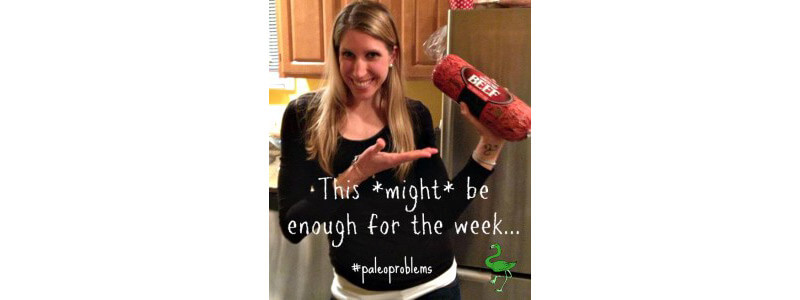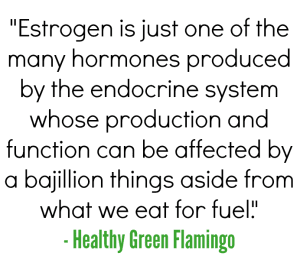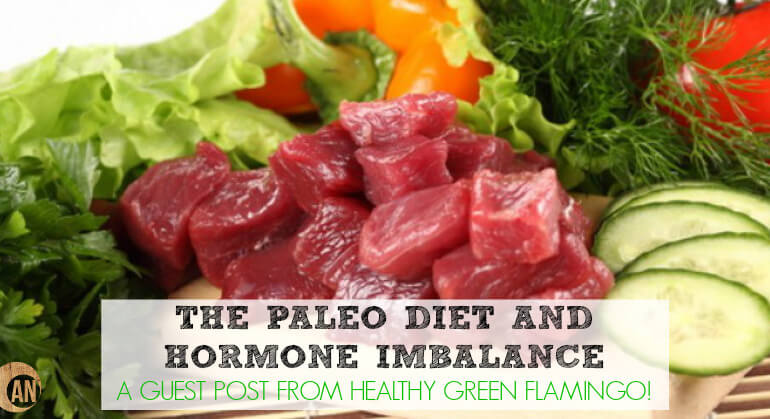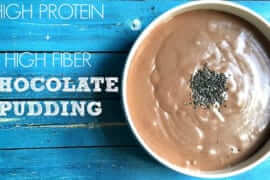Let’s say, hypothetically, that you’ve taken the paleo or primal oath to eliminate processed foods, grains, and beans from your life completely. You eat more vegetables in a week than you’ve ever eaten in your entire life and have an endless supply of almond flour, coconut oil, and canned coconut milk in your pantry. Maybe you’ve even dabbled a bit with kombucha, kimchi and other fermented foods to heal your gut and establish normal excretion. Mad props, yo.

Now let’s say that you’ve done all of that and you’ve reduced or eliminated your inflammation symptoms completely and lost a little bit of belly fat. But for some reason that you can’t quite explain, you STILL experience low-blood sugar, mood swings, low sex drive, headaches, abnormal periods, and other annoying/painful/scary symptoms associated with hormonal imbalances. Even after all of that healthy goodness you’re putting into your body, you still crave something sweet after your meals, so you look up paleo-approved dessert recipes on the Internet to satisfy your sweet tooth. Oh, and your muffin top is still lingering atop those curvy hips of yours, and even though your bloating is gone, that six pack that you expected to see from eating so damn healthy all of the time doesn’t seem to be getting the memo.
What gives?
Well, my lady friend, this is not a hypothetical situation at all. This is exactly what I went through and it took me a long time, a TON of research, multiple conversations with holistic practitioners, and a few certifications of my own to figure out how to take control of my hormone imbalance symptoms. Before I started eating a grain-dairy-legume free/whole foods diet, I was constantly bloated, had joint pain, craved sugar, missed periods, had a dull complexion, had cold hands and feet, dry skin, had excess body fat around my abdomen, had brain fog, and experienced plenty of blood sugar crashes almost every afternoon. Like anyone who finds success in making the switch, the list of previous symptoms went on and on. After switching to paleo, I no longer experienced bloating or joint pain, and had some relief from low-blood sugar episodes but not much else changed.
 Our hormones are affected by everything that we put in and on our bodies. Hormones are chemical messengers in the body, affected by other hormones, and by chemicals that we consume and absorb through our skin. Endocrine disrupting chemicals or EDCs are everywhere. These chemicals wreak havoc on the function of our endocrine system and are found in personal care products, food packaging, animal products, processed foods, conventional produce, and even fabrics.
Our hormones are affected by everything that we put in and on our bodies. Hormones are chemical messengers in the body, affected by other hormones, and by chemicals that we consume and absorb through our skin. Endocrine disrupting chemicals or EDCs are everywhere. These chemicals wreak havoc on the function of our endocrine system and are found in personal care products, food packaging, animal products, processed foods, conventional produce, and even fabrics.
Endocrine disrupting chemicals (EDCs) are extremely prevalent in our environment and food. The bad news? It’s virtually impossible to reduce our exposure to EDCs completely. The good news? Switching to a clean diet, such as paleo or primal, and a “greener” way of living helps to eliminate a significant source of these EDCs. Buying organic produce, avoiding plastic containers, and using sustainable materials such as bamboo, ceramic and stainless steel reduces our exposure to EDCs even further.
In addition to chemical disruption, hormone levels are also affected by physical factors – primarily physical activity, stress, and sleep. Lack of exercise, too much stress, and not enough good quality sleep can cause the glands of the endocrine system to completely rebel. If you’re eating strictly paleo and avoiding toxic chemicals in your environment, but you’re constantly super-stressed, get very little sleep, and exercise once in a while, you are putting yourself at risk for developing a wide range of serious health issues.
Both chemical and physical factors causes a disruption in the endocrine system, and when the endocrine system isn’t functioning properly, all other systems of the body are affected. Even a slight hormone imbalance can affect our mood, thoughts, fertility, sex drive, energy levels, complexion, and much, much more. The human body is a very resilient yet incredibly complex network of cells where each individual cell needs a lot of emotional, mental and physical nourishment to carry out the function that it was designed for and to have a healthy relationship with other cells.
What we eat is a significant factor to living a fulfilling life and although it’s the most logical starting point, it’s not where the journey to optimum health should end. In order to be healthy, happy, and hormonally-balanced, we ladies need to consider all of the factors that affect our bodies and minds. If you’ve switched to a whole-foods diet you’re on the right track. To read more on this topic, check out this post for 10 non-food ways to balance your hormones.
 Karen, the Healthy Green Flamingo, is a holistic health and nutrition coach, blogger, and writer living in the Greater Boston Area. She helps women take control of their hormones, happiness and health using a natural, holistic and bio-individual approach. Also an athlete and environmental scientist, she finds that her body prefers a paleo-based diet and advocates for real food and healthy movement every chance she gets. You can find her on Facebook or read more about her here.
Karen, the Healthy Green Flamingo, is a holistic health and nutrition coach, blogger, and writer living in the Greater Boston Area. She helps women take control of their hormones, happiness and health using a natural, holistic and bio-individual approach. Also an athlete and environmental scientist, she finds that her body prefers a paleo-based diet and advocates for real food and healthy movement every chance she gets. You can find her on Facebook or read more about her here.





